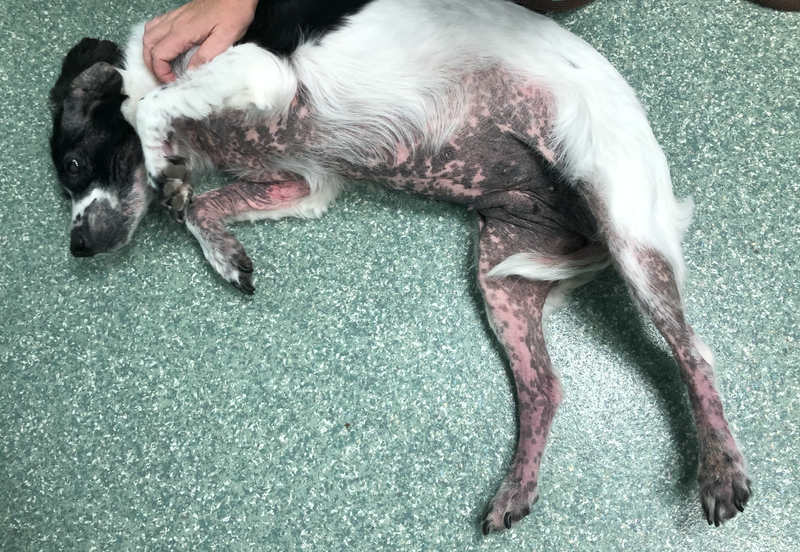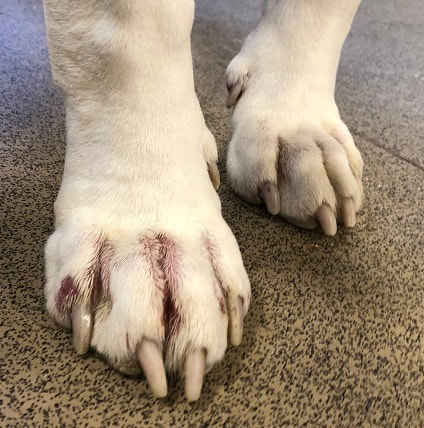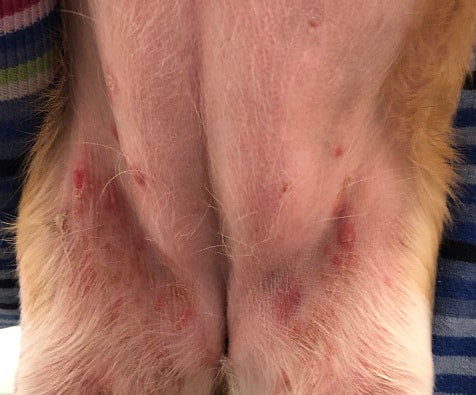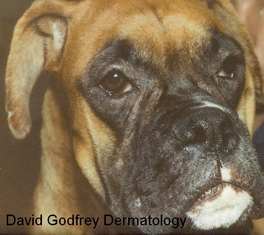Atopic dermatitis (Atopy) in dogs
Here I will explain about itchy dogs, atopic dermatitis and how I diagnose and treat dogs suffering from these problems.
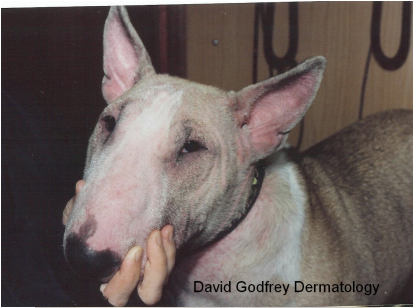
Most dogs with itchiness (called pruritus in medical jargon) usually have one or more of the following problems:
- allergy to things in the air such as pollens or components of house dust, (a disease called atopic dermatitis or atopy)
- reaction to the things they are eating (food allergy)
- bacterial infection (pyoderma)
- yeast infection (Malassezia)
- Sarcoptic mange (Scabies or fox mange)
- Demodex (demodectic mange) or, of course, - fleas (There are other causes but we see these other things less often).
In dogs with atopic dermatitis the immune system reacts inappropriately when the dog comes in contact with the things (allergens) to which it is allergic and this leads to the skin becoming itchy. These dogs have a genetic predisposition to develop allergies. Once the dog starts to damage the skin by scratching and rubbing secondary bacterial and yeast infections commonly develop as well.
Atopic dermatitis affects about one dog in every eight. Some are mildly affected and some severely but all are itchy. Diagnosing whether a dog is atopic is complicated because there are only a few ways in which skin reacts to problems so many skin diseases, caused by different things and with different treatments, all look the same.
- allergy to things in the air such as pollens or components of house dust, (a disease called atopic dermatitis or atopy)
- reaction to the things they are eating (food allergy)
- bacterial infection (pyoderma)
- yeast infection (Malassezia)
- Sarcoptic mange (Scabies or fox mange)
- Demodex (demodectic mange) or, of course, - fleas (There are other causes but we see these other things less often).
In dogs with atopic dermatitis the immune system reacts inappropriately when the dog comes in contact with the things (allergens) to which it is allergic and this leads to the skin becoming itchy. These dogs have a genetic predisposition to develop allergies. Once the dog starts to damage the skin by scratching and rubbing secondary bacterial and yeast infections commonly develop as well.
Atopic dermatitis affects about one dog in every eight. Some are mildly affected and some severely but all are itchy. Diagnosing whether a dog is atopic is complicated because there are only a few ways in which skin reacts to problems so many skin diseases, caused by different things and with different treatments, all look the same.
|
There is now a set way to diagnose atopic dermatitis using the criteria shown opposite and I follow this method.
If a dog has at least five of these features then atopic dermatitis is a possibility BUT other causes of itch will also cause these problems and so it is vital to make sure that they are not present and have been ruled out. Dogs with atopic dermatitis also commonly have recurrent ear problems and itchiness and infections on their faces, abdominal skin and legs. |
The Favrot criteria (adapted) for diagnosing canine atopic dermatitis
(Favrot C, Steffan J, Seewald W & Picco 2010 A prospective study on the clinical features of chronic canine atopic dermatitis and its diagnosis. Veterinary Dermatology 21 23-31) - Onset of signs under three years of age - Dogs mostly living indoors - Steroid-responsive itchiness (common steroids used in dogs include prednisolone and medrone) i.e. the itch goes away when the dog is on steroid medication. - Itchiness without skin lesions at the beginning of the problem - Front feet are affected - Pinnae (ear flaps) are affected - The ear margins are not affected - The back is not affected |
How I work out what problem your dog has
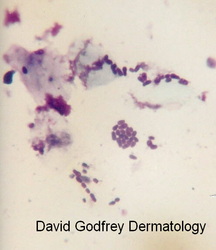
Bacteria under the microscope
When I see an itchy dog first I will ask lots of questions. This is to try to work out which of the criteria listed above are met and which we might have to work out over the next few weeks. Also, which of the other causes of itch are possibly present. The next stage is for me to carefully look at your dog and to take samples to examine under the microscope. Here I am checking for fleas, mites and other parasites and for bacteria and yeasts.
After this I will carefully discuss with you the best way forward to make your dog comfortable and to work out further what is causing the itch. We have to take into account what is possible at home and the costs involved. Usually this will involve trial treatments. Flea control is always essential. Even when previous treatment has ruled out the possibility of fleas being the cause of the problem it is vital that fleas do not appear during the other trials. Food-related problems can only be addressed and identified with a food trial. Although blood tests to diagnose food-related itching are used by some vets they have not yet been shown to be helpful and most veterinary dermatologists consider them to be a waste of the owners’ money. The only way to diagnose or rule out an adverse reaction to food (food allergy) is to run a food trial. The principles of this are shown in the section below.
During this time skin infections may need to be treated or at least prevented by shampooing and tablets.
After this I will carefully discuss with you the best way forward to make your dog comfortable and to work out further what is causing the itch. We have to take into account what is possible at home and the costs involved. Usually this will involve trial treatments. Flea control is always essential. Even when previous treatment has ruled out the possibility of fleas being the cause of the problem it is vital that fleas do not appear during the other trials. Food-related problems can only be addressed and identified with a food trial. Although blood tests to diagnose food-related itching are used by some vets they have not yet been shown to be helpful and most veterinary dermatologists consider them to be a waste of the owners’ money. The only way to diagnose or rule out an adverse reaction to food (food allergy) is to run a food trial. The principles of this are shown in the section below.
During this time skin infections may need to be treated or at least prevented by shampooing and tablets.
Treatment of atopic dermatitis
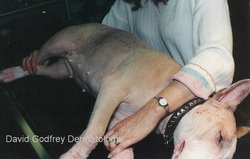
A patient sedated and prepared for intradermal testing
I will discuss the various options with you. Which are best will depend on how bad things are, which parts of the body are affected, the expense and the likelihood of side effects from the different options. Most pets with moderate or severe problems require one of the following five treatments
1. Steroids – these will usually work but their use is limited by side effects. They are safe if given long-term by hydrocortisone aceponate Cortavance spray (as this does not enter the body in an active form) or using prednisolone or methylprednisolone tablets by mouth every other day or less. Quite often it is not possible to get the skin controlled at a level of steroid treatment that avoids side effects
2. Ciclosporin (cyclosporin) (Atopica) - this is a powerful drug – (it given to people having had an organ transplant to stop rejection). It is usually effective but side effects mean that some pets have to stop taking it and it can be too expensive for many owners.
3. Allergen Specific Immunotherapy (ASIT). “Allergy testing” allows an immunotherapy solution to be made containing low numbers of the allergens to which your pet reacts. The exact mix is specific for your pet and is based either on blood test results (measuring an antibody called IgE that reacts to the different pollen, house dust and storage mite and mould allergens) or the results of intradermal testing.
4. Oclacitinib (Apoquel) - this is a new drug and a new type of agent. It has been extensively tested and appears safe and effective but we are just learning exactly how to use it. It is moderately expensive.
5. Lokivetmab (Cytopoint) - new in the UK in 2017 this is a non-drug treatment with high efficacy and safety. It can be used in conjunction with any other treatment but in many dogs it will probably be the only treatment needed. It is a monoclonal antibody targeting the dog's itch that is given by subcutaneous injection at the vets once a month. It is moderately expensive.
There is some evidence that intradermal testing gives better long-term results for ASIT. Sometimes it is best to base ASIT on both blood and intradermal testing together. The pet has to be prepared for testing e.g. steroid treatments have to be withdrawn beforehand.
After allergy testing it takes a few weeks to get the first treatment. Frequent injections are then given – either at the veterinary practice or at home –these build up over a few weeks to the full dose which is then continued as a single injection every few weeks for life. The hope is that the body’s allergic reaction to these allergens is taken away and the itching stops.
Allergy testing gives completely negative results in around 20% of dogs with atopic dermatitis – ASIT is not possible for
these pets. Of those dogs that start ASIT around 60% continue with it for life as their owners find that it is beneficial.
There are other things that we may add into long-term treatment of atopic dogs in addition to one of the main three
treatments:
1. Avoidance of allergens – this may be avoiding dusty areas or country walks at certain times of the year.
2. Shampooing to wash allergens from the skin and to keep the skin hydrated and free from scurf.
3. There are certain drugs that reduce the itch to some extent in some dogs and these can be worth a try – antihistamines
and essential fatty acids are often used.
4. It is always essential to prevent secondary bacterial infections (pyoderma) and yeast infections (Malassezia) with shampoos and tablets if required.
5. Local treatment using other drugs e.g. in ears or on feet when these areas are particularly problematic for an individual.
Treatment combinations used will depend on the patient’s particular needs but those pets that have owners and vets working closely together are those that do best in the long term.
1. Steroids – these will usually work but their use is limited by side effects. They are safe if given long-term by hydrocortisone aceponate Cortavance spray (as this does not enter the body in an active form) or using prednisolone or methylprednisolone tablets by mouth every other day or less. Quite often it is not possible to get the skin controlled at a level of steroid treatment that avoids side effects
2. Ciclosporin (cyclosporin) (Atopica) - this is a powerful drug – (it given to people having had an organ transplant to stop rejection). It is usually effective but side effects mean that some pets have to stop taking it and it can be too expensive for many owners.
3. Allergen Specific Immunotherapy (ASIT). “Allergy testing” allows an immunotherapy solution to be made containing low numbers of the allergens to which your pet reacts. The exact mix is specific for your pet and is based either on blood test results (measuring an antibody called IgE that reacts to the different pollen, house dust and storage mite and mould allergens) or the results of intradermal testing.
4. Oclacitinib (Apoquel) - this is a new drug and a new type of agent. It has been extensively tested and appears safe and effective but we are just learning exactly how to use it. It is moderately expensive.
5. Lokivetmab (Cytopoint) - new in the UK in 2017 this is a non-drug treatment with high efficacy and safety. It can be used in conjunction with any other treatment but in many dogs it will probably be the only treatment needed. It is a monoclonal antibody targeting the dog's itch that is given by subcutaneous injection at the vets once a month. It is moderately expensive.
There is some evidence that intradermal testing gives better long-term results for ASIT. Sometimes it is best to base ASIT on both blood and intradermal testing together. The pet has to be prepared for testing e.g. steroid treatments have to be withdrawn beforehand.
After allergy testing it takes a few weeks to get the first treatment. Frequent injections are then given – either at the veterinary practice or at home –these build up over a few weeks to the full dose which is then continued as a single injection every few weeks for life. The hope is that the body’s allergic reaction to these allergens is taken away and the itching stops.
Allergy testing gives completely negative results in around 20% of dogs with atopic dermatitis – ASIT is not possible for
these pets. Of those dogs that start ASIT around 60% continue with it for life as their owners find that it is beneficial.
There are other things that we may add into long-term treatment of atopic dogs in addition to one of the main three
treatments:
1. Avoidance of allergens – this may be avoiding dusty areas or country walks at certain times of the year.
2. Shampooing to wash allergens from the skin and to keep the skin hydrated and free from scurf.
3. There are certain drugs that reduce the itch to some extent in some dogs and these can be worth a try – antihistamines
and essential fatty acids are often used.
4. It is always essential to prevent secondary bacterial infections (pyoderma) and yeast infections (Malassezia) with shampoos and tablets if required.
5. Local treatment using other drugs e.g. in ears or on feet when these areas are particularly problematic for an individual.
Treatment combinations used will depend on the patient’s particular needs but those pets that have owners and vets working closely together are those that do best in the long term.
|
Sites of clinics
Milton Keynes MK7 7AN Chipping Norton OX7 5SY Worcester WR4 9UP Henley-in-Arden B95 5AN Coventry CV5 7AQ Wolverhampton WV2 1BD Cheltenham GL51 9JW Cheltenham GL53 8EZ |
